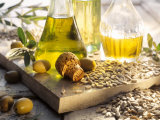Fats:
The Good, The Bad and The Ugly

There is a lot of talk about cutting back on eating fats because the body does not need it. This statement is simply not true! Throughout life, it is essential to provide energy and support growth. It is the most concentrated source of energy our body has. Growing children need more than adults as it is necessary for normal brain development. Adults requite only small amounts. Eating too much can lead to obesity, high blood pressure, heart disease and colon cancer and has been linked to a number of other disorders as well. The secret is to know which variety we should be eating – there are good (healthy) and bad (unhealthy) ones. The healthy varieties are good because the body uses them to nourish the brain, heart, nerves, hormones and all your cells. Your hair, nails and skin also benefit greatly from them. If we do not get enough in our diet our body will actually crave it. There are 2 types of good ones -
Monounsaturates
and
polyunsaturates.
They are the healthier choice, helping reduce the risk of certain diseases. Monounsaturates aren’t essential but polyunsaturates are. They are made up of omega 3 and omega 6 oils and together they help reduce the risk of fatigue, allergies, eczema, heart disease, cancer, PMS and more. The bad and ugly varieties are trans (hydrogenated) and saturated fats. They are found primarily in animal products such as whole/full cream milk, cream, cheese, beef, lamb & pork. Some vegetable products also contain saturates such as coconut and palm kernel oils. The liver uses them to make cholesterol which means that if you eat a lot of it you’re going to end up with high blood cholesterol – the bad LDL cholesterol will especially be raised.

Saturates - Are not essential and it is not good to eat too much
- Found mainly in meat & dairy products
- Raise the LDL or bad cholesterol increasing your risk of coronary heart disease
- Choose leaner cuts of meat, skinless poultry, low fat dairy products, fish & nuts
Trans - Are created by heating liquid vegetable oils in the presence of hydrogen gas – called hydrogenation
- The body can’t make use of them
- They raise the LDL or bad cholesterol level in the blood
- They lower the HDL or good cholesterol reading
- They block the body’s ability to use good polyunsaturates
- Avoid frying foods as the high temperature makes the oil oxidise. So instead of being good for you it creates harmful free radicals in your body. If you do need to fry, use a tiny amount of butter or olive oil as these oxidise less easily
- Found in some margarines, vegetable shortenings, fried foods, baked goods, crackers, candies and other processed foods made with partially hydrogenated vegetable oils
How much? - Fat should make up 20 – 30% of your total calorie intake – as much as possible from the good varieties
- Limit saturates to less than 10% of your total calorie intake
- If you have high blood cholesterol your saturates intake should be even less than 10%
- Try to avoid the hydrogenated variety
Would You Like To Be Part Of
This Site?Why not become part of the Healthy Eating Website! All you do is tell your foodie story or share your favourite recipe here!
Your story or recipe becomes a whole page on this site and part of the healthy eating blog (which shows the site's most recent pages). So become a permanent part of Healthy-Family-Eating.com so others can read, learn and grow from your input! And I'll tweet your Web page at my Twitter account, too!
Come on... join in and have some fun!
Return from Fats to Nutrition Facts
|
